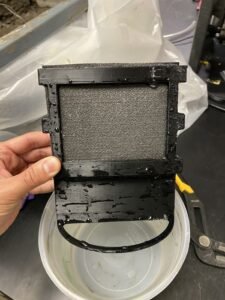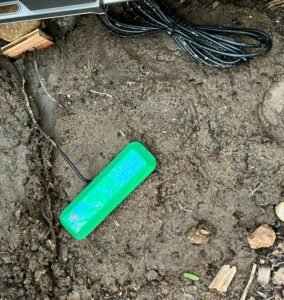A team of researchers from Northwestern University says they have developed a cutting-edge, power-generating fuel cell that runs on dirt by capturing the electricity generated by microbes that live in soil. Previous attempts at microbial fuel cells (MFCs) have been stymied by low power outputs and unreliable performance, but the Northwestern system seems to have conquered these issues.
The inventors of the dirt-powered fuel cell believe it can revolutionize precision farming, while lessening the use of batteries that often contain toxic chemicals and rely on lithium and heavy metals that are a limited resource and can damage crops and soil. They are also making their design open source so farmers everywhere can take advantage of the breakthrough device.
Instead of Building a Better Battery, Researchers Decided to Try Replacing It
“The number of devices in the Internet of Things (IoT) is constantly growing,” said Northwestern alumnus Bill Yen, who led the effort to create a viable MFC. “If we imagine a future with trillions of these devices, we cannot build every one of them out of lithium, heavy metals, and toxins that are dangerous to the environment. We need to find alternatives that can provide low amounts of energy to power a decentralized network of devices.”
This need is especially high in the agricultural industries, where minute sensors covering numerous acres of land require only small amounts of reliable energy to significantly increase crop yields. Unfortunately, farmers are unable to tend to so many devices accurately, especially if they are unable to generate their own power and require constant replacement of batteries.
“If you want to put a sensor out in the wild, in a farm, or in a wetland, you are constrained to putting a battery in it or harvesting solar energy,” Yen said. “Solar panels don’t work well in dirty environments because they get covered with dirt, do not work when the sun isn’t out, and take up a lot of space.”
Batteries are also a challenge, Yen explained, as they ultimately run out of power. “Farmers are not going to go around a 100-acre farm to regularly swap out batteries or dust off solar panels,” he quipped.
To address this problem in a practical yet innovative way, Yen and his team decided to look at devices that could generate reliable power on the spot while also requiring little to no maintenance. The solution turned out to be devices that utilize the electrical generation properties of microbes found right in the dirt.


MFCs Used the Power of Microbes Living in the Dirt to Generate Reliable Electricity
In their published study, the Northwestern researchers point out that creating a fuel cell that runs on dirt is not a new idea. However, developing an MFC that is reliable and can work under both wet and dry conditions has stymied researchers for decades. That’s because MFCs need to stay hydrated and oxygenated to work properly.
“Although MFCs have existed as a concept for more than a century, their unreliable performance and low output power have stymied efforts to make practical use of them, especially in low-moisture conditions,” Yen explained.
Still, the idea of a working MFC seemed to resolve a lot of the issues around sensors powered by batteries and solar panels. They are also attractive because their primary power source, the activity of microbes, is found pretty much anywhere one finds dirt.
“These microbes are ubiquitous; they already live in soil everywhere,” said Northwestern’s George Wells, a senior author on the study. “We can use very simple engineered systems to capture their electricity. We’re not going to power entire cities with this energy. But we can capture minute amounts of energy to fuel practical, low-power applications.”
Like a battery, an MFC contains an anode, a cathode, and an electrolyte. According to the press release announcing the Northwestern team’s work, “MFCs harvest electricity from bacteria that naturally donate electrons to nearby conductors.” This flow of electrons from the anode to the cathode generates an electric circuit that can be captured and used in electronic devices.
Geometry the Key to Viable Fuel Cell that Runs on Dirt
To develop an MFC that could work in wet and dry conditions while still creating reliable, useable power, the Northwestern researchers built and tested four different designs. After nine months of testing and evaluation, they settled on one particular model that they then tested in an outdoor garden. As hoped, the device proved equally reliable in both wet and dry conditions and functioned well enough to power the type of soil sensors farmers are now using to maximize crop yields.
The key, the researchers explain, was in the device’s geometry. Instead of the typical MFC setup where the anode and cathode are parallel to each other, the Northwestern MFC involves a perpendicular design. This small but substantial change allowed the team to place the power-generating elements of the MFC in the dirt while keeping a cap above ground to maintain the oxygenation needed for electricity generation.


“Although the entire device is buried, the vertical design ensures that the top end is flush with the ground’s surface,” they explain. “A 3D-printed cap rests on top of the device to prevent debris from falling inside. And a hole on top and an empty air chamber running alongside the cathode enable consistent airflow.”
They also coated their MFC with a waterproof material so it can breathe during a flood. The result was a working MFC that lasted 1205 longer than similar designs and generated 68 times as much power as needed to run its sensor. The researchers say that this surplus of electricity can run a small, wireless radio antenna embedded in the sensor that can communicate its readings to the farmers a long distance away.
Fuel Cell that Runs on Dirt Is Available to Everyone
The Northwestern team says that all of the materials and components in their MFC are readily available at a local hardware store. This includes the carbon felt used in the cathode that captures the electrons generated by the microbes.
The team also says they are making the designs, tutorials, and simulation tools available to everyone in hopes that farmers can build their own fuel cell that runs on dirt and inventors can work to improve them. That information can be found in their published work, which appears in the January 12th edition of Proceedings of the ACM on Interactive Mobile Wearable and Ubiquitous Technologies.
“With the COVID-19 pandemic, we all became familiar with how a crisis can disrupt the global supply chain for electronics,” said study co-author Josiah Hester, a former Northwestern faculty member who is now at the Georgia Institute of Technology. “We want to build devices that use local supply chains and low-cost materials so that computing is accessible for all communities.”
Christopher Plain is a Science Fiction and Fantasy novelist and Head Science Writer at The Debrief. Follow and connect with him on X, learn about his books at plainfiction.com, or email him directly at christopher@thedebrief.org.

